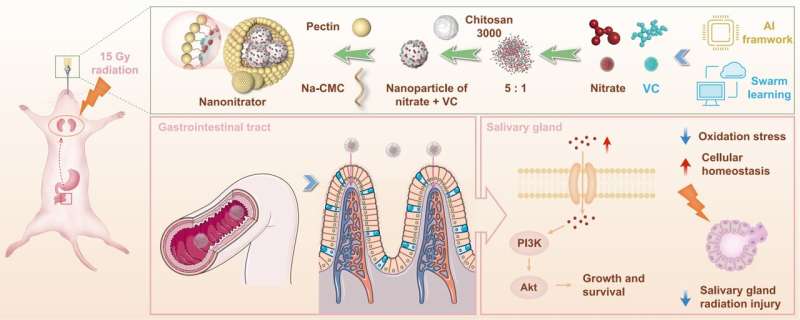A swarm learning-based drug combination prediction system identifying vitamin C as the optimal drug to be combined with sodium nitrate. This combination improved the bioavailability of sodium nitrate and exerted synergistic effects. Subsequently, the team used microencapsulation technology to prepare a nanoparticle named Nanonitrator, with sodium nitrate and vitamin C as its primary components. Nanonitrator prevented tissue damage in a model of radiation-induced salivary gland injury, verifying their improved efficacy over that of sodium nitrate alone. Credit: Science China Press
Radiotherapy is currently the main form of treatment for head and neck malignancies such as nasopharyngeal carcinoma. Within the radiation field of a tumor, salivary glands frequently suffer substantial damage following irradiation, resulting in xerostomia and a series of oral syndromes, which seriously impact the quality of patients' lives.
In 1998, the research team led by Prof. Songlin Wang established a model of miniature pigs to simulate clinical salivary gland injuries induced by radiation in the head and neck region. The model was employed in a series of studies on the mechanism of radiation-induced salivary gland injuries as well as functional reconstruction of the damaged glands.
The team found that exogenous inorganic nitrate supplementation could significantly protect the morphology and function of the salivary glands from radiation injury, suggesting a novel mode of prevention and treatment.
Most existing experimental studies on inorganic nitrate therapy are based on oral administration, including the addition of nitrates to food and drinking water. Orally administered nitrates have low bioavailability, rapid metabolism, and high fluctuation in vivo, making it difficult to achieve pharmacodynamically active concentrations. To resolve these issues and facilitate clinical applications, the team has successfully developed a drug combination prediction system based on swarm learning.
Using a deep learning model, the system was trained on drug-pathway interaction data to construct a drug-pathway network. A graph convolutional neural network was used to construct a drug-target network to uncover optimal drug combinations. The system was used to successfully identify vitamin C as the optimal drug for co-administration with sodium nitrate. This finding provides new ideas and methods for drug co-administration, with important clinical implications for the prevention of various diseases.
From this, the optimal nitrate-to-vitamin C ratio was determined using microencapsulation technology for screening and optimization of the controlled release formulation. Thereby a hydrophobic nanodrug named Nanonitrator was prepared, using a core material solution containing sodium nitrate, vitamin C, and chitosan 3000, whereas sodium carboxymethyl cellulose (Na-CMC) and pectin were used as wall materials.
The core and wall materials were mixed, lyophilized, and crushed into a powder form. The various pH values of gastrointestinal solutions tested in vitro confirmed that Nanonitrator is suitable in oral dosage forms.
Due to their ability to significantly enhance the signal transduction of the PI3K-Akt pathway, Nanonitrator exhibited better effects in maintaining intracellular homeostasis than sodium nitrate alone or sodium nitrate combined in a physical mixture with vitamin C at equivalent oral doses. Nanonitrator reduced radiation-induced oxidative stress in salivary gland cells, reduced ROS content, maintained cellular calcium homeostasis, protected mitochondrial morphology and function, and decreased the number of apoptotic cells.
These results suggest that Nanonitrator could be developed as a novel therapy of multiple applications, with the potential to play an important role in the prevention and treatment of related chronic diseases. Moreover, this study provides new ideas for the development of novel drugs based on inorganic salts.
The work is published in the journal Science Bulletin.
More information: Wen Pan et al, Nanonitrator: novel enhancer of inorganic nitrate's protective effects, predicated on swarm learning approach, Science Bulletin (2023). DOI: 10.1016/j.scib.2023.03.043
Provided by Science China Press
























